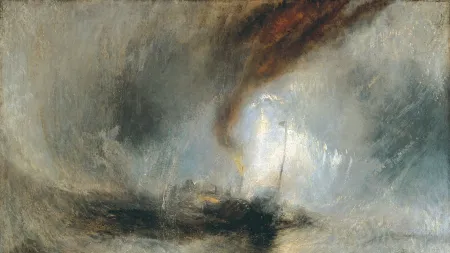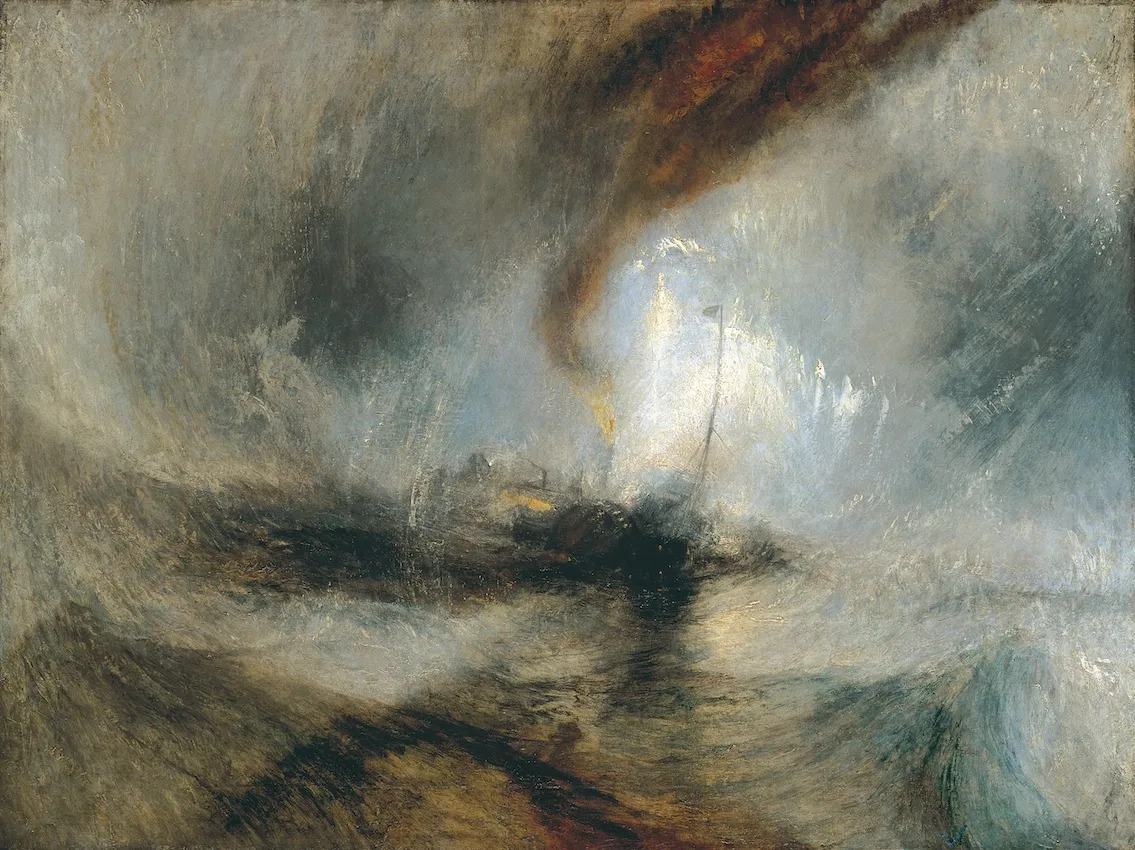
Joseph Mallord William Turner ranks among Britain’s most famous artists, celebrated today for landscapes that rankled his 19th-century contemporaries with their unbridled light and color. His radical legacy lives on in the Turner Prize, awarded annually to a contemporary British artist. He also features on the United Kingdom’s 20-pound note, a fitting tribute for an artist whose work recorded, albeit ambivalently at times, the rise of capitalism and the growing power of industry. For his 250th birthday this year, international institutions are celebrating his diverse and prolific oeuvre.
The son of a barber, Turner (1775–1851) entered London’s Royal Academy Schools in 1789, where he spent his time copying plaster casts of classical sculptures before moving on to life studies of male nudes. He became a consummate draftsman—something concealed by the painterly bravura of his late work—and in his early career he worked in several architect’s studios, refining his technique.
It was in watercolor that he would first distinguish himself, at a time when the medium was growing in importance in Britain, and Turner would continue to produce watercolor views throughout his career. His ability to both control watercolor’s tonality and deploy its luminosity to unprecedented expressive ends is evident in works like Jedburgh Abbey, which sets the ruins of a medieval abbey against the daily labors of local washerwomen.
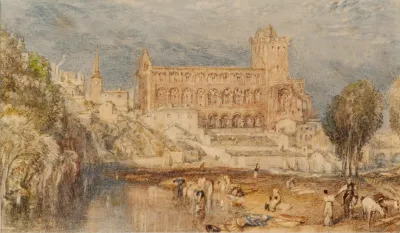
Oil painting was considered the most distinguished form of art in Turner’s time, and the ambitious artist’s first exhibited work in oil demonstrates his savvy understanding of the art market. Fishermen at Sea taps into Britain’s maritime identity while allowing Turner to explore the strong contrast of a dark night sky with the glowing moon and its illumination of the waves. While the two small fishing boats are finely painted, with a draftsman’s detail, in the rising swell Turner probes the possibility of painting to communicate movement, a theme he pursued throughout his career.
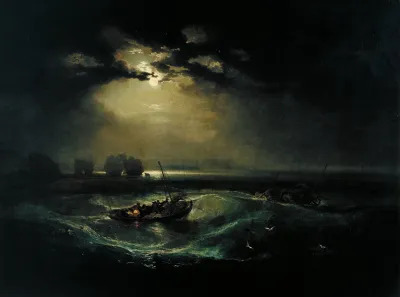
Following on this precocious beginning, Turner painted nearly nonstop for the next 60 years, churning out more than 500 oil paintings and thousands of watercolors, drawings, and sketches. He was elected to the Royal Academy—its youngest-ever member at age 26—in 1802. Despite his growing prominence as an artist, he received only one royal commission, when George IV asked him in 1822 to render the Battle of Trafalgar. The 1805 battle was a signal event of the Napoleonic Wars, resulting in both a decisive naval victory for the British and the death of Vice-Admiral Horatio Nelson, one of the nation’s greatest heroes.
Turner, who was interested in grand paintings of historical importance, rose to the challenge with a massive canvas filled with billowing sails, swirling smoke, and the visible chaos of a battle at sea. Once it was completed, however, some took issue with its historical inaccuracies, including the way Turner conflated distinct moments of the battle and kept Nelson himself out of sight. The painting also was equivocal on the morality of the war, underscoring the costs of victory with the visible bloodshed in the foreground of the scene. The Battle of Trafalgar will return to view at Queen’s House, Greenwich, in October after 18 months of conservation work on the National Maritime Museum.

A brief period of peace between France and Britain in 1802 allowed Turner to travel to the Continent, where he gaped at the Swiss Alps and studied Old Master paintings in the Louvre. But when foreign travel was again restricted by the Napoleonic Wars, Turner and his patrons turned their attention inward to the United Kingdom, fueling interest in landscape as a genre. A number of Turner’s watercolor views of the countryside were engraved and published between 1827 and 1838 as Picturesque Views in England and Wales. These engravings allowed Turner to distribute his work more widely, securing his reputation (and his pocketbook).
The topographic views ennoble the British landscape with dramatic lighting and atmospheric effects, perhaps most startlingly in a scene of Stonehenge engulfed in storm, with a shepherd and his flock struck down by lighting. Watercolor studies for the Stonehenge engraving are among the 37,500 sketches, drawings, and watercolors available to virtual viewers through Tate’s online catalog of the artist’s work, which will be completed this year. The so-called Turner Bequest that forms the basis of the catalog was the result of the artist’s contested will—he had hoped his considerable fortune would be used to support indigent landscape painters, but his relatives objected and ultimately claimed the money, while the works of art went to the nation.
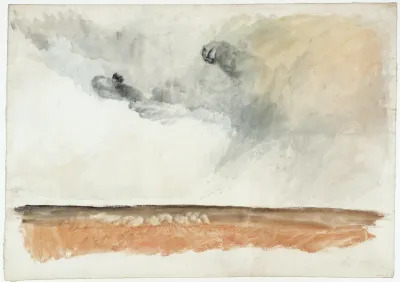
The attention to sheep—their contorted bodies, the fuzzy texture of their coats, the suggestion of their bleating—in the engraved view of Stonehenge hints at Turner’s surprising interest in the animal world, the subject of an exhibition at Sandycome Lodge in Twickenham, once the artist’s country retreat (built after his own designs) and now a house museum. “Turner’s Kingdom: Beauty, Birds and Beasts,” on view through October 26, features exquisite studies of animals, revealing Turner’s careful consideration of the natural world even as his work became increasingly expressive.
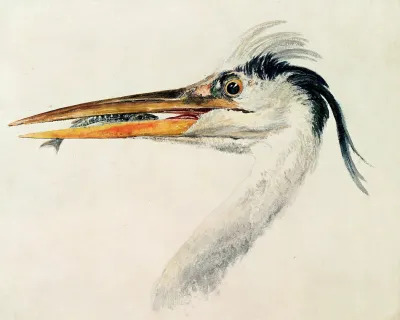
Turner’s life paralleled the explosive developments of 19th-century industry, including the advent of the spinning mill, the steamboat, and the railroad, and he benefited from the patronage of new-money industrialists. His paintings of the 1820s regularly feature the black smudges of steam travel, coal-dark plumes against otherwise radiant skies. He celebrated the blistering speed of this new age in Rain, Steam, and Speed —The Great Western Railway, juxtaposing a train hurtling into the foreground with a tiny hare to the left, emblem of the now-surpassed speed of nature. In recent years, scientists have turned to Turner’s work as documents of environmental degradation. Whether Turner was consciously engaging with the ethics of pollution remains up for debate, but in his devotion to atmosphere his work inevitably captured Britain’s changing climate.
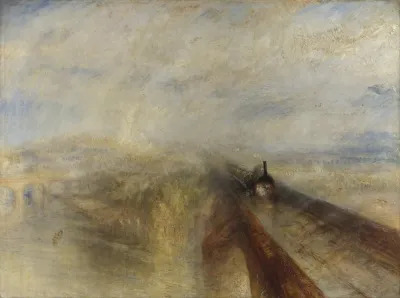
One of Turner’s most prominent British contemporaries was John Constable (1776–1837), and the two were in conversation in their time. In response to Turner’s tendency to augment his works in the days prior to an exhibition opening (known as “varnishing days”), Constable complained, “he has been here and fired a gun.” Turner’s muscular sublime is often opposed to Constable’s quiet picturesque, and viewers will have the chance to compare the two for themselves at the exhibition “Turner and Constable,” opening in November at Tate Britain in London.
Both artists were present when London’s Houses of Parliament burned in October 1834, though Turner’s bombastic brushwork was better suited to the flames and fury of the spectacle. To try to capture the extraordinary intensity of the fire, Turner relied heavily on megilp, an additive that allowed him to better manipulate his paint and build layers of highlights, but one that has since caused the painting to darken. Turner frequently employed experimental media, making industrialization not just the subject but the very material of his work. His vibrant colors were the result of new, synthetically manufactured products, many of which were unstable and have faded with time.
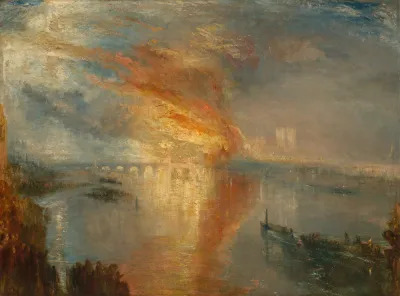
Like all good modern artists, Turner was reviled by conservative critics who were unprepared for the “sparkling insanity” they encountered in his canvases, which they saw as “art . . . deformed into madness.” But he also had a staunch proponent in the artist and writer John Ruskin. Ruskin first came to Turner’s defense when the burgeoning critic was only 17. In response to a negative review, Ruskin wrote that Turner was “a meteor, dashing on in a path of glory which all may admire, but in which none can follow.”
Ruskin elaborated on the singularity of Turner’s greatness in Modern Painters, a five-volume work published between 1843 and 1860. Ruskin found something in Turner that matched his own profound spirituality, claiming that Turner’s work “makes [the spectator] a sharer in his own strong feelings and quick thoughts; hurries him away in his own enthusiasm; guides him to all that is beautiful; snatches him from all that is base; and leaves him more than delighted,—ennobled and instructed, under the sense of having not only beheld a new scene, but of having held communion with a new mind, and having been endowed for a time with the keen perception and the impetuous emotions of a nobler and more penetrating intelligence.”
It’s precisely what Turner leaves out of his views that makes them available for such communion, the sketchiness of his images inviting the viewer’s imagination. One such picture—intended as a study, and thus especially loose in execution—is on view at Turner Contemporary in Margate, where it was painted. Waves Breaking on a Lee Shore at Margate (Study for “Rockets and Blue Lights”) shows just how far the artist had pushed his technique from Fishermen at Sea, relying on sparse, gestural strokes of white highlighting to convey the direction and energy of the waves.
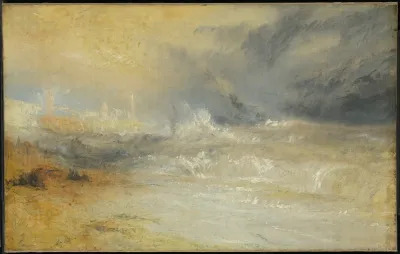
Ruskin was the first owner of one of Turner’s most notorious pictures, Slave Ship (Slavers Throwing Overboard the Dead and Dying, Typhoon Coming On). Prompted by growing abolitionist movements in Britain, Turner based the painting on the account of the Zong, a slaver whose captain had thrown its human cargo overboard in the hopes of recovering insurance money. Centered on a blazing sun, the painting seems to deliberately pull attention from the human suffering of the foreground—chained limbs reaching up from the depths. The resulting tension between beauty and horror led William Thackeray to demand, “Is the picture sublime or ridiculous? Indeed I don’t know which.” Contemporary poets, including M. NourbeSe Philip and David Dabydeen, critique Turner’s de-specification of the very real victims of the massacre.
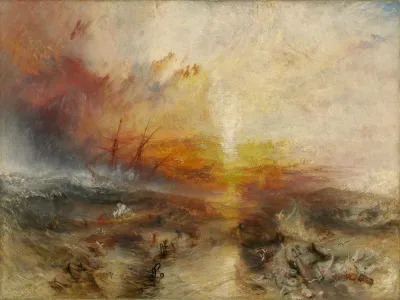
Turner rarely left a clear statement of his personal stake in political or social matters. He instead productively inhabited the circumstances of his time, a moment when the world was being radically reconfigured and old traditions were being replaced by modern innovations (embodied by The Fighting Temeraire Tugged to Her Last Berth to Be Broken Up, in which an aging ship deployed in the battle of Trafalgar is dragged by a steamship to its final resting place). Rather than choosing a side, Turner sets these two forces in play, to dynamic and spectacular results.


Jannik Sinner Raised His Wimbledon Trophy Wearing a Rolex Daytona

Hot Wheels and Alex and Ani Drive Nostalgia With Racing-inspired Jewelry Collection

OpenAI’s open ChatGPT model has been delayed again

FSU Amateur Woad Takes 3rd at LPGA Major, Forfeits $547K in Winnings


